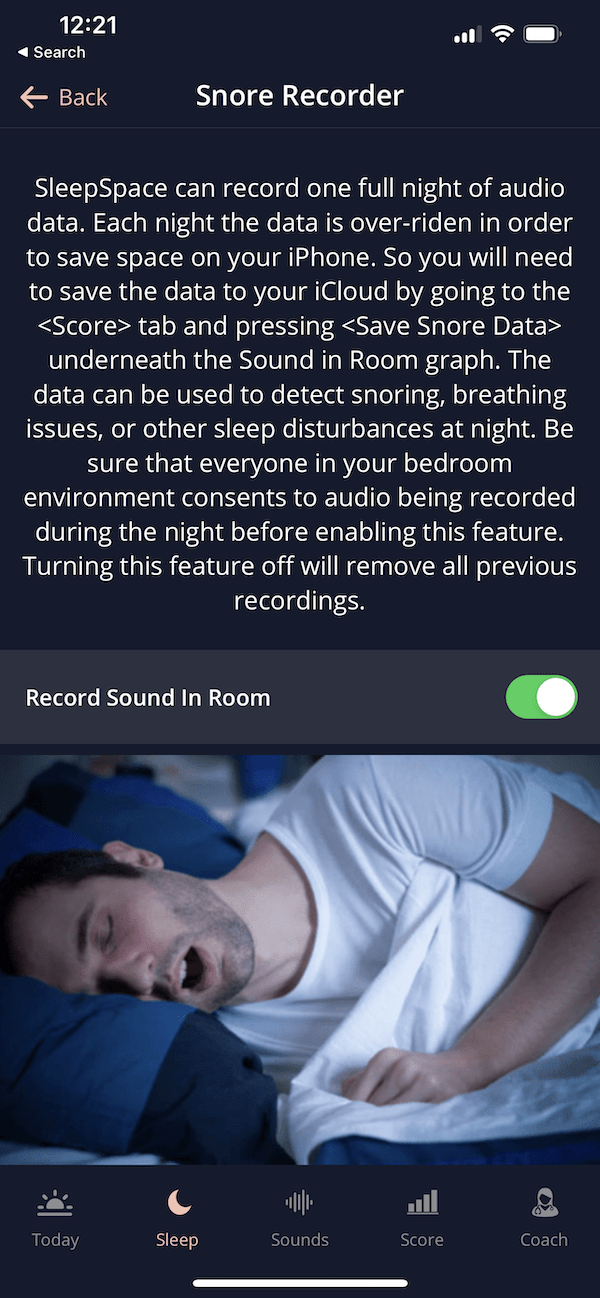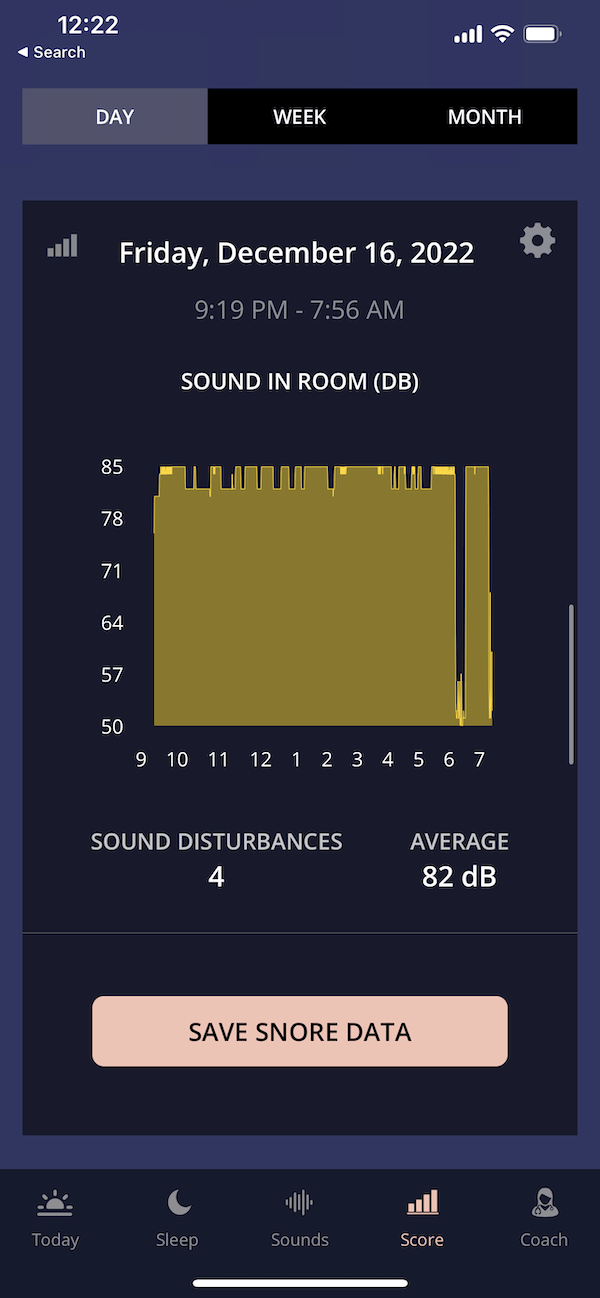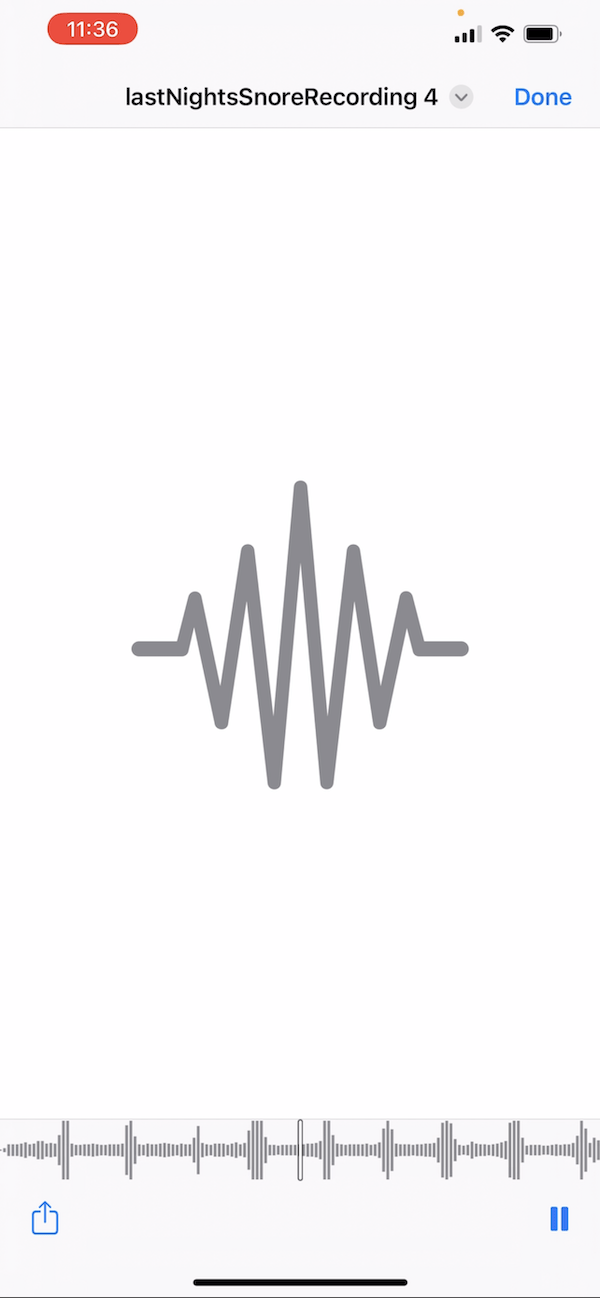SleepSpace Snore Detector
Guide to tracking your snoring with SleepSpace and a demo of what an unhealthy snore sounds like
By Dr. Dan Gartenberg
Last Updated: March 30, 2023
Why measure snoring and breathing patterns at night
There is a major difference between a typical snore and a sleep apnea snore when it comes to our health and well being. Sleep apnea is related to increased hypertension, cardiovascular disease, Alzheimer's disease, and about 6 years off your life when untreated. While "normal" snoring due to a cold or sickness is not usually a problem, chronic snoring could be a sign of a deeper issue like sleep apnea. When the snore is erratic, like is the case in the demo recording below, that's when things might be particularly problematic. If you think you might have sleep apnea, you really really really ought to get diagnosed and treated!
In the brief audio recording featured below from SleepSpace, a typical snore is measured next to a hypopnea, which is an instance of sleep apnea. Sleep apnea translates from the Latin root "absence of breathing." See the below video of what the difference between a typical snore and a sleep apnea snore sounds like.
Often times the sleeper is completely unaware of this issue, so recording the sound in the room can be an important first step in helping them get the motivation to get diagnosed and treated. You can easily do this using the SleepSpace app that will record sound throughout the night and seamlessly display it on your iPhone. Then send the recording to a sleep specialist who can guide you on the diagnosis path. Additionally, through a collaboration with Wesper, you can now get diagnosed for sleep apnea without leaving the comfort of your own home, through a link found within the SleepSpace app. Enter code "SLEEPSPACE23" for 10% off!
Other signs of sleep apnea
• Teeth grinding
• Waking up and feeling short of breath
• A Excessive daytime sleepiness
• High blood pressure
• Chest-pain at night
• Restless sleeping
• Morning Headaches
Guaranteed sleep help at no cost to you with our free trial
How to turn on the SleepSpace Snore Detector
1) Download the SleepSpace App from the Apple App Store (not yet available on Android)
2) Make sure your phone is updated to iOS 16 or later and make sure iCloud is enabled
3) Edit your Sleep Journey in the Sleep Screen and scroll down to turn on the snore recorder
4) Make sure your sleep partner consents to you recording sound throughout the night
5) Start your Sleep Journey
6) Save the recorded sound in the morning (see below images)
7) To listen to the recording, go to the "Files" app that is native on every iPhone



Listen to the difference between a normal snore and a sleep apnea snore
- There is a typical snore pattern until about 35 seconds
- Then you can hear the sleeper gasping for air at around 35 seconds in
- Starting at about 1 min 10 seconds in they stop breathing
- This lasts for about 30 second! This can be typical for sleep apnea to stop breathing for that long
- Finally they begin to breath again towards the end of the video
You can imagine how this is not healthy for the heart, brain and overall health of anyone
Guaranteed sleep help at no cost to you with our free trial
Measuring sound in the bedroom is not just important for measuring snoring, but relevant to anyone who wants to better understand their bedroom environment. Often times, subtle sounds wake us up in the middle of the night the negatively impact sleep. I've seen it myself in our sleep lab when I noticed that an air conditioner turning on was waking up sleepers. Additionally, SleepSpace plays sleep enhancing sounds throughout the night designed to entrain deeper sleep. You can listen to how SleepSpace adjusts these sounds when this feature is turned on.
IMPORTANT NOTE: Each night the sound recording will be overwritten in order to save space on your phone, so to save it, you will have to press the save recording button each morning, which stores the file in your iCloud account.
PRIVACY: No recorded data is ever saved on SleepSpace servers, for your privacy and protection.
For increased snore detection accuracy, purchase the SleepSpace Smart Bed which positions the phone closer to you at night for more precise recording of sound: https://smartbed.sleepspace.com/
Other signs of sleep apnea:
1) Teeth grinding
2) Waking up and feeling short of breath
3) Excessive daytime sleepiness
4) High blood pressure
5) Chest-pain at night
6) Restless sleeping
7) Morning headaches
Even if you don't have apnea, snoring can be a major issue for your sleep partner by disrupting their sleep. There are other solutions for typical snoring as well such as a nasal dilator, addressing a deviated septum, or treating your allergies. Other Risk Factors: Alcohol and being overweight often makes sleep apnea worse.
Recommended Treatments
1) CPAP has the best effects of treating the problem.
2) A mandibular device has efficacy for mild to moderate and can be attained through a dentist trained in developing these special mouthpieces.
3) Myofunctional therapy and weight loss show some efficacy as well, but nothing close to the effectiveness of CPAP.
4) These solutions in combination are probably the most effective treatments.
Fun Sleep Fact: We often snore more during REM sleep due to our body being paralyzed during this phase, and is often why snoring happens later on in the night (when we have more REM).
Hint: For Apple Watch users, low pulse oxygenation could also be a sign that you should get diagnosed for sleep apnea and SleepSpace with Apple watch displays these pulse oxygenation values to you at night.